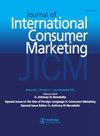Special Issue on the Use of Foreign Language in Consumer Marketing
IF 2.8
Q3 BUSINESS
引用次数: 1
Abstract
Welcome to this Special Issue of Journal of International Consumer Marketing! The first two articles of this issue address the topic of the use of foreign language in consumer marketing. This has been a topic of personal interest to me for some time. I have observed advertising in North America and Europe which contains the occasional foreign-language word or phrase to convey authenticity or stress country-of-origin. It is interesting to speculate how much foreign language is “enough:” a few words in Spanish (“Yo quiero Taco Bell”) or German (“Fahrvergn€ ugen”) will be an interesting curiosity in North American advertising, and continental European ads that use English are unlikely to cause much difficulty. Nevertheless, companies want to be sure they are sending messages that are decoded correctly by the target audience, and overreliance on foreign text would constitute noise in the channel. In fact, companies go out of their way to ensure the correct choice of words in order to appeal to the target audience. This holds for brand names as well: as one of many examples, Procter & Gamble carefully translates Mr. Clean two different ways for French-speaking customers (“Monsieur Propre” in France, and “Monsieur Net” in Quebec), due to local preferences. I’ve also been fascinated by the translation of Western brand names into Chinese characters. Names may be chosen to sound alike, or to have a desirable meaning. The best translations manage to do both. A classic example is the Chinese translation of IKEA, which uses characters that mean “suitable for the home,” and which sound similar to the European pronunciation of the brand name. Ideally, a special issue accomplishes a couple of objectives: it presents some of the newest thinking on an emerging research topic, and also provides direction for future work to scholars working in this research area. I am hoping that researchers interested in the use of foreign language in consumer marketing will find it to be one of their “go-to” issue to use for years to come. The first article in this special issue, by Raine Ng, Gerard P. Prendergast, and Ludwig M. K. Chang, explores the effect of different message features on the persuasiveness of Chinese-language online word-ofmouth. Ng et al. use a combined content analysis-laboratory experiment design to identify features of Chineselanguage reviews of Hong Kong restaurants, and to determine their effect on attitude and purchase intention. The authors use negativity effect, the elaboration likelihood model, and the theory of planned behavior to discuss their results. The second article, by Dursun Yener and Mertcan Taşçı o glu, examined the interaction effects between brand name, product label, and product type on consumer perceptions. They hypothesize that purchase motivation will differ by product type, so possibly the effect of a foreign-language brand name or product label will also depend on product type. The authors carried out a scenario-based experiment to manipulate brand name, product label, and product type. They found significant interactions: product evaluation and purchase intention were higher in the case of foreign brand names and bilingual product labels, as well as a significant three-way interaction including product type. To make this issue even more helpful to the research academic, I am providing below a list of six articles appearing in recent issues of JICM which addressed issues related to the use of foreign language in consumer product advertising, packaging, and brand name selection. This has been a topic that has garnered some interest over the years at JICM. I hope that readers will find the six articles below to be useful resources, as well as the two new articles appearing in this issue. The articles are:消费营销中的外语运用特刊
欢迎收看本期《国际消费者营销杂志》特刊!本期的前两篇文章讨论了在消费者营销中使用外语的话题。一段时间以来,这一直是我个人感兴趣的话题。我观察到北美和欧洲的广告中偶尔会出现外语单词或短语,以传达真实性或强调原产国。推测多少外语是“足够的”是很有趣的:在北美广告中,西班牙语(“Yo quiero Taco Bell”)或德语(“Fahrvergn€ugen”)的几个单词将是一个有趣的好奇心,而使用英语的欧洲大陆广告不太可能造成太大困难。尽管如此,公司希望确保他们发送的信息被目标受众正确解码,而过度依赖外国文本会在频道中构成噪音。事实上,为了吸引目标受众,公司会竭尽全力确保正确的措辞。这也适用于品牌名称:作为众多例子之一,宝洁公司根据当地偏好,为讲法语的客户精心翻译了两种不同的方式(法国的“Monsieur Propre”和魁北克的“Monmieur Net”)。我也被西方品牌名称翻译成汉字所吸引。可以选择听起来相似的名字,也可以选择具有理想含义的名字。最好的翻译能够做到这两点。一个经典的例子是宜家的中文翻译,它使用的字符意思是“适合家居”,听起来与品牌名称的欧洲发音相似。理想情况下,一期特刊可以实现两个目标:它介绍了对一个新兴研究主题的一些最新想法,也为该研究领域的学者提供了未来工作的方向。我希望对在消费者营销中使用外语感兴趣的研究人员会发现,这是他们未来几年要使用的“首选”问题之一。本期特刊的第一篇文章由Raine Ng、Gerard P.Prendergast和Ludwig M.K.Chang撰写,探讨了不同的信息特征对汉语网络单词“mouth”的说服力的影响。Ng等人采用内容分析-实验室实验设计相结合的方法来识别香港餐馆中文评论的特征,并确定其对态度和购买意愿的影响。作者使用消极效应、阐述可能性模型和计划行为理论来讨论他们的结果。第二篇文章由Dursun Yener和Mertcan Taşçıo glu撰写,研究了品牌名称、产品标签和产品类型对消费者感知的交互作用。他们假设购买动机会因产品类型而异,因此外语品牌名称或产品标签的影响也可能取决于产品类型。作者进行了一个基于场景的实验来操纵品牌名称、产品标签和产品类型。他们发现了显著的交互作用:在外国品牌名称和双语产品标签的情况下,产品评价和购买意愿更高,以及包括产品类型在内的显著的三方交互作用。为了让这个问题对研究学者更有帮助,我在下面列出了最近几期JICM中出现的六篇文章,这些文章涉及在消费品广告、包装和品牌名称选择中使用外语的问题。多年来,这一直是JICM关注的一个话题。我希望读者会发现下面的六篇文章是有用的资源,以及本期出现的两篇新文章。文章包括:
本文章由计算机程序翻译,如有差异,请以英文原文为准。
求助全文
约1分钟内获得全文
求助全文
来源期刊
CiteScore
7.60
自引率
6.10%
发文量
29
期刊介绍:
The Journal of International Consumer Marketing examines consumer and organizational buyer behavior on a cross-cultural/national and global scale combining up-to-date research with practical applications to help you develop an action plan for successful marketing strategy development. Business professionals, policymakers, and academics share insights and "inside" information on a wide range of cross-cultural marketing issues, including international business customs, negotiating styles, consumer brand loyalty, price sensitivity, purchasing and leasing, consumer satisfaction (and dissatisfaction), and advertising.

 求助内容:
求助内容: 应助结果提醒方式:
应助结果提醒方式:


